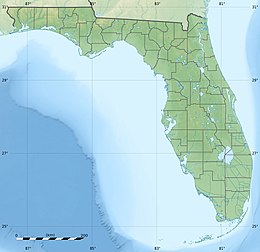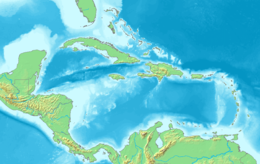| Revision as of 23:41, 6 July 2008 editMr3641 (talk | contribs)1,167 editsm added coordinates← Previous edit | Latest revision as of 15:26, 1 March 2024 edit undoDonald Albury (talk | contribs)Administrators62,046 edits Reverted good faith edits by 2601:589:4984:3C00:8453:C052:14B6:1861 (talk): Not listed in templateTags: Twinkle Undo | ||
| (48 intermediate revisions by 37 users not shown) | |||
| Line 1: | Line 1: | ||
| {{Short description|Island in the lower Florida Keys, United States}} | |||
| ] is on Sugarloaf Key. The road goes to Sugarloaf Elementary school and a residential area of the island.]] | |||
| {{Distinguish|text=], in Central Abaco, the Bahamas}} | |||
| {{Infobox islands | |||
| | name = Sugarloaf Key | |||
| | native_name = | |||
| | native_name_link = | |||
| | sobriquet = | |||
| | image_name = Florida Keys SPOT 1283.jpg | |||
| | image_caption = A satellite image of Sugarloaf Key | |||
| | map = | |||
| | map_caption = | |||
| | pushpin_map = Florida#Caribbean | |||
| | pushpin_label = | |||
| | pushpin_label_position = top | |||
| | pushpin_map_alt = | |||
| | pushpin_relief = 1 | |||
| | coordinates = {{Coord|24.628|N|81.514|W|type:isle_region:US-FL|display=it}} | |||
| | etymology = | |||
| | location = ] | |||
| | grid_reference = <!-- UK only --> | |||
| | archipelago = ] | |||
| | waterbody = ] | |||
| | area_sqmi = | |||
| | rank = | |||
| | length_mi = | |||
| | width_mi = | |||
| | coastline_mi = | |||
| | highest_mount = | |||
| | elevation_ft = | |||
| | country = {{USA}} | |||
| | country_admin_divisions_title = State | |||
| | country_admin_divisions = ] | |||
| | country_admin_divisions_title_1 = County | |||
| | country_admin_divisions_1 = ] | |||
| | country_admin_divisions_title_2 = | |||
| | country_admin_divisions_2 = | |||
| | demonym = | |||
| | population = | |||
| | population_as_of = | |||
| | density_km2 = | |||
| | ethnic_groups = | |||
| | website = | |||
| | additional_info = | |||
| }} | |||
| '''Sugarloaf Key''' is a single island in the lower ] that forms a loop on the Atlantic Ocean side, giving the illusion of separate islands. Although frequently referred to simply and with technical accuracy as "Sugarloaf Key", this island contains two distinct island communities, known as ] and ]. | |||
| '''Sugarloaf Key''' is one of the larger islands in the lower ], about 15 miles east of ]. | |||
| ==History== | |||
| It is located between ] and ]. | |||
| The name Sugarloaf, is variously attributed as arising from either an Indian mound on the east side of Upper Sugarloaf Key, north of the present highway was said to look like an old-fashioned ] or from the variety of pineapple called "sugarloaf" that was once grown in the area.<ref>{{cite web|url=http://www.sugarloaflodge.net/History.html|title=The Good Family Welcomes You to Sugarloaf Lodge|work=Sugarloaf Lodge|access-date=31 October 2016}}</ref> These pineapples are rarely in commercial use any longer since they are soft and do not travel well. The unincorporated community of ] on the island was the location of one of the stations of the ].{{Citation needed|date=November 2023}} | |||
| ==Geography== | |||
| ⚫ | ] (or the ]) crosses |
||
| The island is somewhat U-shaped, with Upper Sugarloaf Sound and ] separating the island into Upper Sugarloaf Key and Lower Sugarloaf Key. So called, upper and lower, simply referencing the relative nature of their geographic positions, not as distinct islands. Lower Sugarloaf Key is about {{convert|13|mi|km|abbr=on}} from ], between Park Key and ] and Upper Sugarloaf Key is about {{convert|15|mi|km|abbr=on}} east of ], between Park Key and ]. Though Lower Sugarloaf Key has a greater density of population, it is smaller in area than Upper Sugarloaf Key. | |||
| ==Ecology== | |||
| Its earlier names were Glen Island and Perkey. Due to its loop shape it is sometimes referred to as two separate Keys; '''Sugarloaf Key''' and ], separated by Upper Sugarloaf Sound and ]. | |||
| Plant species native to the island include ], ], ] and ].<ref name="Smithsonian">{{cite web|url=http://www.smithsonianmag.com/travel/sugarloaf-key-florida-keeping-good-company-30591514/?all|title=Sugarloaf Key, Florida: Keeping Good Company|work=Smithsonian Magazine|first=Barbara|last=Ehrenreich|date=July 2009|access-date=31 October 2016}}</ref> Of fauna, ]es are found on the island, and ]s, ], ], ] and ] can be seen in the local waters.<ref name="Smithsonian" /> | |||
| ==Community== | |||
| It is thought to have been named Sugarloaf because either an Indian mound there on the east side of (upper) Sugarloaf Key, north of the present highway was said to look like an old-fashioned loaf of sugar, or for the sugarloaf pineapples that were once grown in the area. | |||
| Lower Sugarloaf Key has family owned Sugarloaf Lodge and restaurant, an airport, Sugarloaf Volunteer Fire Station, and ]. | |||
| Upper Sugarloaf Key has two public schools, a church, restaurant, commercial offices, public campground and the ]. | |||
| Covering {{convert|14|acre|ha|abbr=on}},<ref>{{harvnb|Farren|2003|p=}}</ref>{{page needed|date=October 2016}} Sugarloaf Key has the southernmost ] campground in North America.<ref>{{cite web|url=http://www.insideflorida.com/detail/sugarloaf-key-resort-koa-kampground/|title=Sugarloaf Key Resort KOA Kampground|work=Inside Florida|access-date=31 October 2016}}</ref> | |||
| It is the upper portion of one large island. The island is "U"-shaped, with Upper Sugarloaf Sound and ] in the center. Although larger in area than Lower Sugarloaf Key, it is less densely populated. | |||
| ==Transportation== | |||
| The upper portion of the island ('''Sugarloaf Key''', also known locally as '''Upper Sugarloaf Key''') has a public school, church, restaurant, and KOA campground. The lower portion of the island (]), although smaller in area, is more densely populated and is also called ]. It has Sugarloaf Lodge and restaurant, an airport, a volunteer fire department, and ], built in 1929 and listed on the National Register of Historic Places. The tower was built based on the Hygiostatic Bat Roost plans of Dr. Charles Campbell, an early pioneer of bat studies, by a man named Perky to control the mosquito (and hence malaria) problem in the Lower Keys, but reportedly, when the bats were put in, they flew away. Mr. Perky intended to found a city named after himself, but did not succeed due to the local mosquitoe and malaria problem. | |||
| ⚫ | ] (or the ]) crosses Upper Sugarloaf Key at approximately mile markers 19–20.5 and Lower Sugarloaf Key at approximate mile markers 16.5–17.5. | ||
| Sugarloaf Key is already part of the Overseas Highway and will soon join other islands of the Florida Keys as part of the ] connecting mainland Florida to Key West via bicycle path(s). | |||
| == References == | |||
| '''Notes''' | |||
| {{Reflist}} | |||
| '''Bibliography''' | |||
| *{{cite book|first=Rick|last=Farren|title=Highroad Guide to the Florida Keys and Everglades|publisher=John F. Blair|year=2003|isbn=9780895872807|oclc=947133946}} | |||
| ==Further reading== | |||
| *{{cite web|url=http://www.historicfloridakeys.org/historicfloridakeys/Resources_for_Preservation_files/Sugarloaf%20Key's%20Historic%20Resources.pdf|title=Sugarloaf Key's Historic resources|first=Jim|last=Horn|work=Historic Florida Keys Foundation|date=25 March 2007|access-date=31 October 2016}} | |||
| *{{cite web|url=https://www.dep.state.fl.us/cmp/programs/files/sugarloaf_celcp_2011.pdf|title=Sugarloaf Beach Ecological/Historical Conservation Project|work=Florida Department of Environmental Protection|access-date=31 October 2016}} | |||
| *{{cite web|url=http://www.keyshistory.org/SL-Sugarloaf-Key.html|title=History of Sugarloaf Key|first=Jerry|last=Wilkinson|work=Keys Historeum|access-date=31 October 2016}} | |||
| ==External links== | |||
| *{{commons category-inline|Sugarloaf Key}} | |||
| {{Florida-geo-stub}} | |||
| {{Florida Keys}} | {{Florida Keys}} | ||
| {{Coord|24.636875|N|-81.553917|E|display=title}} | |||
| {{authority control}} | |||
| ⚫ | ] | ||
| ] | |||
| ] | ] | ||
| ] | ] | ||
| ⚫ | ] | ||
Latest revision as of 15:26, 1 March 2024
Island in the lower Florida Keys, United States Not to be confused with Sugar Loaf Cay, in Central Abaco, the Bahamas. A satellite image of Sugarloaf Key A satellite image of Sugarloaf Key | |
  | |
| Geography | |
|---|---|
| Location | Gulf of Mexico |
| Coordinates | 24°37′41″N 81°30′50″W / 24.628°N 81.514°W / 24.628; -81.514 |
| Archipelago | Florida Keys |
| Adjacent to | Florida Straits |
| Administration | |
| State | Florida |
| County | Monroe |
Sugarloaf Key is a single island in the lower Florida Keys that forms a loop on the Atlantic Ocean side, giving the illusion of separate islands. Although frequently referred to simply and with technical accuracy as "Sugarloaf Key", this island contains two distinct island communities, known as Lower Sugarloaf Key and Upper Sugarloaf Key.
History
The name Sugarloaf, is variously attributed as arising from either an Indian mound on the east side of Upper Sugarloaf Key, north of the present highway was said to look like an old-fashioned loaf of sugar or from the variety of pineapple called "sugarloaf" that was once grown in the area. These pineapples are rarely in commercial use any longer since they are soft and do not travel well. The unincorporated community of Pirates Cove on the island was the location of one of the stations of the Overseas Railroad.
Geography
The island is somewhat U-shaped, with Upper Sugarloaf Sound and Park Key separating the island into Upper Sugarloaf Key and Lower Sugarloaf Key. So called, upper and lower, simply referencing the relative nature of their geographic positions, not as distinct islands. Lower Sugarloaf Key is about 13 mi (21 km) from Key West, between Park Key and Saddlebunch Keys and Upper Sugarloaf Key is about 15 mi (24 km) east of Key West, between Park Key and Cudjoe Key. Though Lower Sugarloaf Key has a greater density of population, it is smaller in area than Upper Sugarloaf Key.
Ecology
Plant species native to the island include buttonwood, poisonwood, sea grape and thatch palm. Of fauna, ibises are found on the island, and dolphins, parrotfish, snapper, barracuda and octopus can be seen in the local waters.
Community
Lower Sugarloaf Key has family owned Sugarloaf Lodge and restaurant, an airport, Sugarloaf Volunteer Fire Station, and Sugarloaf Key Bat Tower.
Upper Sugarloaf Key has two public schools, a church, restaurant, commercial offices, public campground and the Great White Heron National Wildlife Refuge.
Covering 14 acres (5.7 ha), Sugarloaf Key has the southernmost KOA campground in North America.
Transportation
U.S. 1 (or the Overseas Highway) crosses Upper Sugarloaf Key at approximately mile markers 19–20.5 and Lower Sugarloaf Key at approximate mile markers 16.5–17.5.
Sugarloaf Key is already part of the Overseas Highway and will soon join other islands of the Florida Keys as part of the Florida Keys Overseas Heritage Trail connecting mainland Florida to Key West via bicycle path(s).
References
Notes
- "The Good Family Welcomes You to Sugarloaf Lodge". Sugarloaf Lodge. Retrieved 31 October 2016.
- ^ Ehrenreich, Barbara (July 2009). "Sugarloaf Key, Florida: Keeping Good Company". Smithsonian Magazine. Retrieved 31 October 2016.
- Farren 2003
- "Sugarloaf Key Resort KOA Kampground". Inside Florida. Retrieved 31 October 2016.
Bibliography
- Farren, Rick (2003). Highroad Guide to the Florida Keys and Everglades. John F. Blair. ISBN 9780895872807. OCLC 947133946.
Further reading
- Horn, Jim (25 March 2007). "Sugarloaf Key's Historic resources" (PDF). Historic Florida Keys Foundation. Retrieved 31 October 2016.
- "Sugarloaf Beach Ecological/Historical Conservation Project" (PDF). Florida Department of Environmental Protection. Retrieved 31 October 2016.
- Wilkinson, Jerry. "History of Sugarloaf Key". Keys Historeum. Retrieved 31 October 2016.
External links
 Media related to Sugarloaf Key at Wikimedia Commons
Media related to Sugarloaf Key at Wikimedia Commons